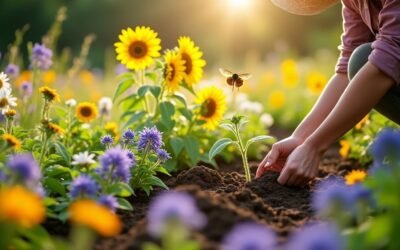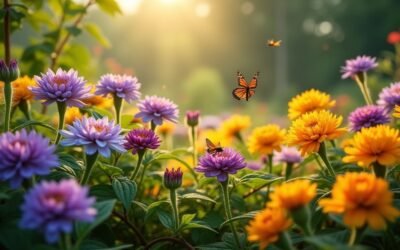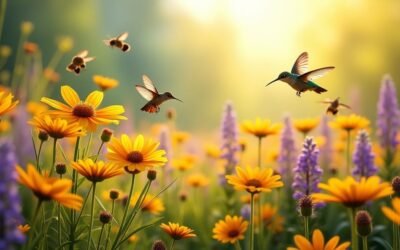Pollinator flowers are essential for cultivating vibrant backyard ecosystems, as they supply important nectar and pollen. Plants like milkweed, coneflower, and lavender attract diverse pollinators, enhancing genetic diversity while supporting food production, accounting for one in three bites consumed. To maximize ecological benefits, individuals should plant species with overlapping bloom times and group them in clusters of three feet, ensuring visibility for foraging pollinators. Additionally, integrating native plants fosters compatibility and stability within the local environment, enriching biodiversity. By carefully considering these strategies, gardeners can create supportive habitats, enhancing ecological balance and resilience, revealing deeper insights into sustainable practices.
Main Points
- Include native wildflowers like Milkweed and Coneflower to attract butterflies and bees while enhancing the local ecosystem.
- Plant a diverse selection of blooms with overlapping flowering periods to provide food for pollinators from spring to fall.
- Group plants in clusters of three feet to increase visibility and foraging efficiency for pollinators.
- Utilize organic practices, avoiding pesticides to maintain a healthy environment for pollinators and other beneficial insects.
- Incorporate legumes such as White Clover and Birds Foot Trefoil to improve soil quality and support ecosystem diversity.
Importance of Pollinator Plants
Pollinator plants play an essential role in maintaining vibrant ecosystems today. They support ecological balance by enhancing pollinator behavior, ultimately contributing to genetic diversity and robust plant populations. Through their rich nectar and pollen, these plants provide refuge and sustenance, ensuring that pollinators thrive. By stabilizing soils and improving air quality, they connect the intricate web of life, promoting overall ecosystem health. Furthermore, pollinators facilitate 1 in 3 bites of food, underscoring their vital importance to our food systems. Additionally, flowering plants like dandelions provide critical nectar sources during early spring when many other plants have not yet bloomed. Plants such as the Water Forget-Me-Not play a crucial role by providing consistent nectar availability for pollinators throughout the growing season.
Popular Pollinator Flower Varieties
Creating a thriving ecosystem requires not just the presence of pollinators, but also the right mix of flowers that attract these essential creatures.
Varieties like Milkweed and Coneflower cater to pollinator preferences through vivid flower colors, drawing in butterflies and bees. Additionally, Sunflowers and Lavender not only offer nourishment but also enhance the landscape, creating harmonious environments to support biodiversity. These plants play a crucial role in supporting pollinator populations by providing nectar and pollen necessary for their sustenance. Furthermore, incorporating species like Wood Forget-Me-Not can provide nectar and pollen throughout spring and summer, enriching the overall diversity of blooms in the garden. Calendula officinalis, with its bright blooms, is another excellent choice for attracting insect pollinators, further enriching the garden ecosystem.
Seasonal Bloom and Plant Diversity

A diverse array of flowering plants throughout the growing season is essential for maintaining a vibrant pollinator-friendly ecosystem. Continuous bloom timing, achieved through overlapping flowering periods, guarantees pollinators find nectar consistently. By incorporating various native species, gardeners enhance plant compatibility, supporting numerous pollinator types. This deliberate selection minimizes gaps, fostering a rich habitat that thrives from spring's first bloom to fall's final flourish. This approach not only attracts diverse pollinators but also promotes the stability of ecosystems, ensuring a healthy balance within the garden. Additionally, including plants like white clover can provide essential nectar sources that support pollinator populations throughout the growing season. The inclusion of legumes such as Birds Foot Trefoil can improve soil quality through nitrogen fixation, benefiting both plants and pollinators alike.
Effective Planting Strategies
Effective planting strategies play an essential role in fostering a thriving ecosystem for pollinators.
Employing strategic plant positioning by grouping plants in clumps of at least three feet enhances visibility and foraging efficiency. Additionally, color coordination helps attract a wider array of pollinators, as large, colorful plant drifts create visually stimulating landscapes.
Native species, offering abundant nectar, ultimately support diverse pollinator populations. Including plants like Salad Burnet can significantly enhance garden biodiversity and nourish a variety of beneficial pollinators.
Enhancing Local Ecosystems

By engaging in habitat restoration and fostering community involvement, they can create vibrant environments for pollinators. Planting diverse native species not only attracts beneficial insects but also guarantees healthy cross-pollination, essential for fruit and seed production. Notably, incorporating Vipers Bugloss(Vipers Bugloss) can significantly enhance pollinator visitation rates, supporting a thriving ecosystem. This biennial plant's extended flowering period ensures a consistent food source for local pollinators throughout the summer months, further bolstering ecological health. This collective effort cultivates resilient ecosystems, improving both biodiversity and the ecological balance crucial for sustaining local wildlife.
Maintenance and Support Tips
Creating a thriving ecosystem for pollinators doesn't stop with planting; ongoing maintenance and support play significant roles in sustaining these environments.
Utilizing pesticide alternatives is imperative for protecting these key species, while soil enrichment, achieved through organic methods like cover crops, promotes healthy growth. Regular care, such as providing fresh water and avoiding modern hybrids, further nurtures a flourishing habitat for diverse pollinators. Additionally, considering nitrogen-fixing plants can enhance soil quality and support overall ecosystem health. Incorporating plants like Common Vetch can provide essential benefits to the soil and local biodiversity, enhancing the overall effectiveness of your garden.


